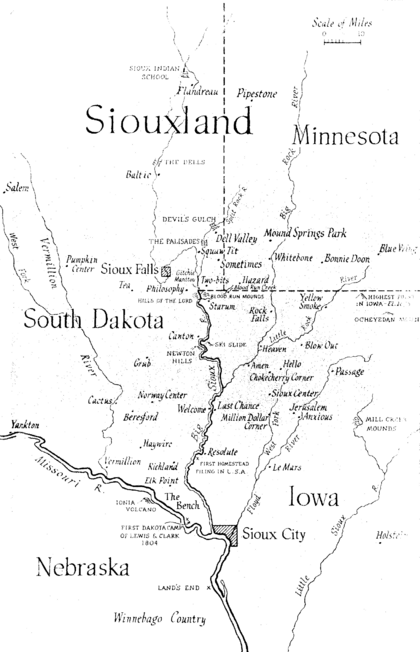Siouxland facts for kids
Siouxland is a special area in the United States where four states meet: South Dakota, Minnesota, Nebraska, and Iowa. It gets its name from the Big Sioux River, which flows through it. People who live in Siouxland are sometimes called Siouxlanders.
A "vernacular region" is a place where people feel connected. They share a history, interests, and a common identity. These areas are like mental shortcuts to describe places and people. They show a "sense of place" but usually don't follow official state borders.
The main part of Siouxland stretches from Sioux City, Iowa, up to Sioux Falls, South Dakota. This area includes parts of northwestern Iowa, northeastern Nebraska, southeastern South Dakota, and the very southwest corner of Minnesota.
The name "Siouxland" was first used by an author named Frederick Manfred in 1946. Manfred was born in Doon, Iowa, a small town in this region.
Contents
How Siouxland Got Its Name
Frederick Manfred grew up in this area. He wrote many novels set in Minnesota, South Dakota, Iowa, and Nebraska. But he felt these state names alone didn't quite fit his stories.
Manfred wanted one name for this whole area. He said, "I wanted to find one name that meant this area where state lines have not been important." He first thought of "Land of the Sioux," but it was too long. So, "Siouxland" was created in 1946.
The next year, the name appeared in the beginning of Manfred's third novel, This Is the Year. He wrote about a robin flying north:
At last, in late March, he arrived in Siouxland. He wheeled over the oak-crested, doming hills north of Sioux City, flew up the Big Sioux River, resting in elms and basswoods....
Time magazine reviewed the novel in 1947. They helped spread the name "Siouxland" by quoting from the book. By 1948, a sports editor in Sioux City started using "Siouxland teams." Soon, businesses and local groups also began using the name, making it widely known.
For example, Orlyn A. Swartz bought a finance company in Sioux City in 1948. He renamed it Siouxland Finance Co. This was one of the first businesses to use the name. Even decades later, a company called Siouxland Insurance Agency still used it.
In 1950, only two businesses used the name "Siouxland." By 1953, there were nine. But by 1990, the Sioux City phone book listed 65 businesses with "Siouxland" in their name. The Sioux Falls phone book had 11 more.
Where Are Siouxland's Borders?
Since Siouxland is a "vernacular region," it doesn't have official borders. Many people in Sioux City think "Siouxland" just means the area around Sioux City. But not everyone agrees.
For example, in 1990, a person from Ida Grove wrote to the Sioux City Journal. They asked, "Just where is Siouxland?" They were upset because the newspaper said the "first baby born in Siouxland" was in Sioux City. But a baby was born earlier that day in Ida Grove!
People near Sioux Falls wanted their own regional name. They started using "Sioux Empire." Frederick Manfred was a bit sad about this. He felt that people in Sioux Falls thought "Siouxland" only meant "Sioux City." Manfred had drawn a map for his book This Is the Year. His map showed Siouxland covering the whole lower Big Sioux River area. At that time, he lived in Luverne, Minnesota, which he considered part of Siouxland.
In 1995, the Sioux Falls Public Library and the Minnehaha County Rural Public Library joined together. They formed Siouxland Libraries.
So, "Just where is Siouxland?" The answer can change depending on who you ask. Like most unofficial regions, Siouxland is pretty much wherever people think it is.
Major Cities in Siouxland
The two biggest cities in Siouxland are Sioux Falls, South Dakota, and Sioux City, Iowa. Another important city is Norfolk, Nebraska. It's a major business center in northeast Nebraska, but it's on the edge of what's usually called Siouxland.
The Sioux Empire Area
The area around Sioux Falls is often called the "Sioux Empire." This includes counties like Minnehaha, Lincoln, McCook, and Turner. This region also includes nearby parts of southwest Minnesota. It was part of Frederick Manfred's original idea for Siouxland.
Cities Often Called Part of Siouxland
Here are some cities that are usually considered part of Siouxland:
Iowa
- Akron, Iowa
- Bronson, Iowa
- Cherokee, Iowa
- Climbing Hill, Iowa
- Correctionville, Iowa
- Denison, Iowa
- Hawarden, Iowa
- Hinton, Iowa
- Hornick, Iowa
- Hull, Iowa
- Ida Grove, Iowa
- Kingsley, Iowa
- LeMars, Iowa
- Lawton, Iowa
- Little Sioux, Iowa
- Merrill, Iowa
- Moville, Iowa
- Okoboji, Iowa
- Onawa, Iowa
- Orange City, Iowa
- Rock Rapids, Iowa
- Rock Valley, Iowa
- Sac City, Iowa
- Salix, Iowa
- Sergeant Bluff, Iowa
- Sheldon, Iowa
- Sioux Center, Iowa
- Sioux City, Iowa
- Sloan, Iowa
- Spencer, Iowa
- Storm Lake, Iowa
Minnesota
Nebraska
- Allen, Nebraska
- Bancroft, Nebraska
- Beemer, Nebraska
- Coleridge, Nebraska
- Dakota City, Nebraska
- Hartington, Nebraska
- Homer, Nebraska
- Hoskins, Nebraska
- Magnet, Nebraska
- Maskell, Nebraska
- Newcastle, Nebraska
- Norfolk, Nebraska
- Obert, Nebraska
- Pender, Nebraska
- Pierce, Nebraska
- Pilger, Nebraska
- Ponca, Nebraska
- Rosalie, Nebraska
- South Sioux City, Nebraska
- Stanton, Nebraska
- St. Helena, Nebraska
- Wakefield, Nebraska
- Walthill, Nebraska
- Wayne, Nebraska
- West Point, Nebraska
- Winnebago, Nebraska
- Winside, Nebraska
- Wisner, Nebraska
- Wynot, Nebraska
South Dakota


